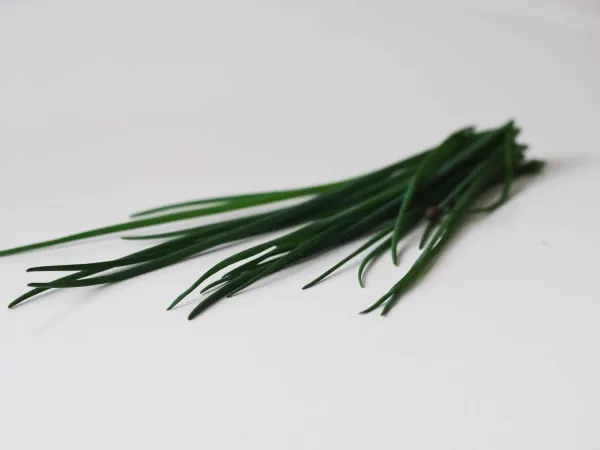Chives
Vegetable
Age Suggestion
6 months
Iron-Rich
No
Common Allergen
No

When can babies eat chives?
Chives may be introduced as soon as baby is ready to start solids, which is generally around 6 months of age.
Background and origins of chives
Chives are an allium from the family of plants that includes leeks, scallions, shallots, and other onions, but their dainty green stems are milder and sweeter in taste. The entire plant is edible, including the roots and flowers, which smell like garlic. Chives are widely used as a culinary herb all over Asia, Europe, Southwest Asia, and more. It adds bright grassy flavor to dishes, and some cultures even treat the aromatic stalks as medicine thanks to their diuretic and antibacterial qualities.
Chives are so delicate that they are often served raw because they lose their flavor when dried or cooked. Check out our ideas on how to introduce this beloved herb during baby’s solid foods journey.
★Tip: Chives about to wilt in your fridge? Mince them and mix with soft butter, then freeze it. A scoop of frozen chive butter works wonders for chicken, fish, rice, and steak dishes. It’s also delicious slathered on toasted bread or mixed into scrambled eggs!
Videos
Are chives healthy for babies?
Yes. Chives contain fiber, folate, and vitamins A, C, and K, as well as trace amounts of calcium, copper, and iron. Their flowers even contain a little vitamin E—an important antioxidant. It also contains an amazing plant compound called kaempferol, which may have anti-cancer properties, amongst many other beneficial phytonutrients such as carotenoids, polyphenols, and more. That said, chives probably won’t pack a big nutritional punch in your little one’s diet because they are often served in small quantities as a garnish. But while chives may not be a superfood, they do have a superpower: chives (like all herbs) are a great tool to enhance flavor without adding salt.
★Tip: Chives are easy to grow and even store-bought chives store well in the fridge. Since only small quantities typically are eaten at one time, here’s how to preserve the rest for up to a week in the fridge: store extra unwashed chives in a towel or paper towel, placed in a plastic bag, rolled to eliminate excess air but with the end of the bag partially unsealed (to prevent them from becoming mushy). Alternatively, place the roots in a jar of water on your counter.
Are chives a common choking hazard for babies?
No. Chive stems should not pose any unusual risk, though chive flowers could if not chopped or pulled apart before serving. As always, make sure you create a safe eating environment, stay within an arm’s reach of baby during meals, and check out our age-appropriate serving suggestions.
For more information on choking, visit our sections on gagging and choking and familiarize yourself with the list of common choking hazards.
Are chives a common allergen?
No. Allergic reactions to chives are rare, but not unheard of. People who are sensitive to garlic or onions may also be sensitive to chives as they are members of the same family of plants, the lily family. While information on Oral Allergy Syndrome and chives is limited, individuals with Oral Allergy Syndrome (also called pollen fruit syndrome), and in particular, those with sensitivities to grass pollen or mugwort pollen (a weed), may also be sensitive to other vegetables within the lily family. Oral Allergy Syndrome typically results in short-lived itching or burning in the mouth and is unlikely to result in a dangerous reaction.
As you would when introducing any new food, start by offering a small quantity for the first couple of servings. If there is no adverse reaction, gradually increase the quantity over future meals.
Recommended Guide: Introducing Allergens
How to serve chives for babies with baby-led weaning?
Every baby develops on their own timeline, and the suggestions on how to cut or prepare particular foods are generalizations for a broad audience.
6 to 9 months old:
Fold minced chives and/or minced chive flowers into soft, scoopable foods like congee (rice porridge), egg frittata, mashed vegetables, or yogurt.
9 to 18 months old:
This is the time to boost the herbs and spices in your dishes, as many food preferences start taking root during this stage. Use chives and chive flowers liberally in your cooking, and don’t forget about breakfast. Minced chives in scrambled eggs or mascarpone cheese spread on toasted bread are two delicious options!
18 to 24 months old:
Around this time, children may develop strong food preferences, but try not to cave by only serving favorite foods. Continue to cook with chives and offer what the rest of the family is eating. Chives can add onion flavor in many dishes, including dumplings, eggs, lentil salad, meatballs, quick breads, and noodles to name a few. They can also be used as a garnish to add bright color and flavor to spreads and finished dishes.
Written by
Expert Tips Delivered to Your Inbox
Sign up for weekly tips, recipes and more!
The content offered on SolidStarts.com is for informational purposes only. Solidstarts is not engaged in rendering professional advice, whether medical or otherwise, to individual users or their children or families. No content on this site, regardless of date, should ever be used as a substitute for direct medical advice from your doctor or your medical or health professional, nutritionist, or expert in pediatric feeding and eating. By accessing the content on SolidStarts.com, you acknowledge and agree that you are accepting the responsibility for your child’s health and well-being. In return for providing you with an array of content “baby-led weaning” information, you waive any claims that you or your child may have as a result of utilizing the content on SolidStarts.com.







